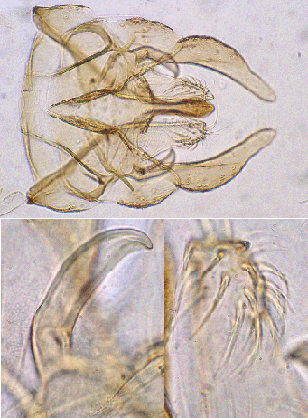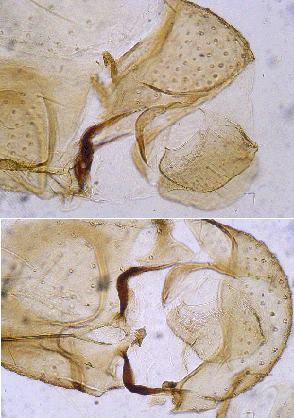C. 'tyleri' Martinformerly Chironomus oppositus f. tyleri - Martin and Lee 1984In BOLD Bin: BOLD:AAF3284(along with the other forms of C. oppositus, and C. 'jacksoni')
Named for Dr Peter Tyler, at that time at the University of Tasmania, who pointed us to the type locality of this species and facilitated others parts of our field work in Tasmania.This species occurs in southern states of the mainland and on Tasmania and the Bass Strait Islands. It appears that there has been some differentiation between these two groups of populations since the separation of Tasmania and the islands from the mainland.The rationale for considering this as a separate species comes largely from the banding sequences of the polytene chromosomes, along with distinct frequencies of studied allozymes (Martin 2011a).The adults are very similar to those of members of the C. oppositus group, but tend to be somewhat larger, wing length over 4 mm; anterior tarsi without a strong beard. Accurate identification is currently only possible from the sequences of the polytene chromosomes. Despite this, conventional types are designated in the hope that distinguishing characters may be found in the future. The types are specimens reared from cytologically identified egg masses to ensure accurate identification. See description of C. tyleri holotype male Males:
Head: antennae and mouth parts brown. Frontal tubercles present, length about 27.2 (14-23) micron, and 2.15 (1.3-3.2) times longer than wide. AR about 2.9-3.2. Clypeus 0.64 (0.56-0.76) times the diameter of the antennal pedicel, with 26.2 (23-31) setae.
Palp segments (micron): 63.5 : 73: 233 : 253 : 388; P5/P4 1.53 (1.39-1.63); P5/P3 1.68 (1.49-1.78).
Thorax generally greenish with brown stripes; thorax pruinose, postnotum and sternopleuron yellowish brown.
Setae: achrosticals - 15 (11-18); dorsocentrals - 16 (13-21); prealar - 5.9 (5-7); supraalar 1; scutellar - 7.5 (5-10) in anterior row, 15 (12-21) in posterior row (total 22.5 (17-35)).
Wings with anterior veins hardly darker than posterior, crossvein slightly darkened.
Wing length 4.43 (4.32-4.68) mm; width 0.9-1.0 mm. VR: 0.98 (0.96-1.01). Scf on branchiolum 3.1 (2-4); 23(15-31) setae on squamal fringe.
Legs yellowish green, unbanded.
Leg lengths (microns) and proportions as follows:
Male
| Fe
| Ti
| Ta1
| Ta2
| Ta3
| Ta4
| Ta5
| LR
| F/T
| Ta5/Ti
| PI
| 1545
| 1400
| 2195
| 1110
| 910
| 780
| 340
| 1.53-1.63
| 1.08-1.12
| 0.24-0.26
| PII
| 1690
| 1560
| 950
| 505
| 380
| 245
| 180
| 0.59-0.63
| 1.04-1.11
| -
| PIII
| 1910
| 1970
| 1400
| 780
| 600
| 370
| 220
| 0.61-0.72
| 0.95-1.00
| -
| BR - 1.78-2.22 Male abdomen generally greenish with narrow to broader saddle markings on the anterior segments, gradually extending in length from about tergum V to occupy most of the tergum by segment VIII. 
Male terminalia of the holotype of C. 'tyleri' (above); superior volsella (below left); setae of inferior volsella (below right).Hypopygium similar to other members of C. oppositus-group; 9.2 (6-13) setae in a single patch medially on TIX; superior volsella of D-type, about as e of Strenzke (1959); inferior volsella, with simple setae, reaching about 2/3 to 1/4 of distance to tip of anal point. Gonostylus moderately swollen and narrowing relatively gently over distal half to third, with about 5 setae near the tip (4+1 or 1+3+1). Female:
Antennal segments (micron): 213(0.34) : 135(0.59) : 146(0.50) : 128(0.58) : 215. AR 0.34 (0.31-0.37); A5/A1 1.01 (0.89-1.09). Clypeal width about 1.5 times the diameter of the antennal pedicel; 31.7 (25-35) clypeal setae.
Frontal tubercles present, about 40.25 (28-51) µm and 1.87-2.45 times longer than wide.
Palp segments (micron): 63 : 63 : 215 : 250 : 434; P5/P4 1.56-1.82; P5/P3 1.77-2.09
Setae: acrostichals - 16; humeral 7.7 (6-10) linear or with 4-5 in a group; ; dorsocentrals - 21-25 (h+dc 28.8(22-34)); prealar - 6; supraalar - 1; scutellar - 8.7 (6-11) in anterior row, 14.7 (14-16) in posterior row: total scutellars 23.3 (20-27).
Wing length 4.32 (4.00-4.52) mm; width 1.12 (1.10-1.16) mm; VR: 0.95 (0.92-0.98). 3-5 SCf on brachiolum, 23.4 (20-26) setae on squamal fringe.
Leg lengths (microns) and proportions as follows:
Female
| Fe
| Ti
| Ta1
| Ta2
| Ta3
| Ta4
| Ta5
| LR
| F/T
| Ta4/Ti
| PI
| 1675
| 1395
| 2260
| 1060
| 895
| 805
| 345
| 1.56-1.69
| 1.19-1.22
| 0.53-0.63
| PII
| 1745
| 1615
| 955
| 500
| 365
| 245
| 180
| 0.57-0.61
| 1.07-1.09
| -
| PIII
| 1900
| 2005
| 1410
| 755
| 600
| 360
| 215
| 0.69-0.71
| 0.93-0.96
| -
| BR 1.13-1.75; 93-104 Sensilla chaetica on hind tibia

Female terminalia of C. 'tyleri' - dorsal view (above); ventral view (below). Genitalia: 2-3 setae on GcIX; segment X a crescent 189 (159-243) Ám long, greatest width 50 (48-53) Ám, 3.96 (3.0-5.1) times longer than greatest width and with 9.3 (6-11) setae. Cercus with an essentially square dorsal posterior margin, then curved ventral margin and basal bulge (see figure above). Molecular data:
Mt COI - see Barcoding of Life Database (BOLD BIN: AAF3284) and Martin (2011a). These sequences are shared with the forms of C. oppositus, presumably due to ongoing low levels of hybridization.
ITS-2 - see Martin (2011a). The basis for considering this to be a distinct species is that the basic pattern of the polytene chromosomes is different on some chromosome arms from that of other members of the oppositus-group. It is obvious that some hybridization occurs on the mainland, but in Tasmania there are some unique sequences which show a general cline from low frequencies in the north-east down to the south and then up to higher frequencies in the north west. As well the effective male determining gene is on arm G, which is otherwise only found in some populations of f. whitei, and might be the result of introgreesion from C. 'tyleri'. The case is also supported by a phylogenetic analysis based on allozyme and inversion frequencies. Types: Holotype male: Bellerive (49.87°S, 147.37°E), Tasmania, AT.9.12, from Egg mass #25 (coll. 11-xi-1978) (M2)..
Allotype female: Data as holotype male (F4).
Paratypes: Larva and associated polytene chromosomes (on separate slides), 1 km n. Arthur River, Tasmania (43.05°S, 144.65°E) AT.41.1, from egg mass #2, sl. 2.01F.
Type material currently in collection of Jon Martin, but will eventually be distributed to the ANIC and other institutions. Found: New South Wales – Lake Eucumbene; Kiandra; Thredbo Village.
South Australia – Lake Edward (37.633°S, 140.600°E) & Lake Leake (37.617°S, 140.583°E),
Tasmania – Arthur River (43.05°S, 144.65°E); Bellerive; Blackmans Lagoon; Cambridge; Campbelltown; Lake Dulverton; Little
Swanport; Longford; 15 Km Queenstown; Strahan; Whites Lagoon, Tunbridge. Flinders Island – Mount Strzelecki
Farm, Emita; Ranga. King Island – Mt. Stanley area (40.05°S, 144.00°E); 3-tree Lagoon (39.63°S, 143.95°E); Pearshape Lagoon
(39.90°S, 144.0°E).
Victoria – Anglesea; Botanical Gardens, Melbourne; Exhibition Gardens, Carlton; Footscray Park; Eureka Stockade, Ballarat East
(37.55°S, 143.53°E); Horden Vale; Manns Beach; Mitcham; Moggs Creek; Monteith Flat; Wallington, nr. Ocean Grove; Squeaky Beach
and Derby River, Wilsons Promontory. [ Return to Index| Go to C. 'tyleri' immatures ] |

